Leadership and Management Report: Za Za Bazaar - Theories and Styles
VerifiedAdded on 2022/11/30
|11
|4201
|498
Report
AI Summary
This report delves into the realm of leadership and management, utilizing the Za Za Bazaar restaurant as a case study. It begins by assessing various classical management theories, including centralized leadership, labor specialization, wage incentives, bureaucracy, and scientific management, and their applicability to the restaurant. The report then explores the multifaceted role of a leader, encompassing coaching, connecting, motivating, communicating, visionary, and strategic functions. Different leadership styles such as authoritarian, participative, and delegative are examined, highlighting their advantages and disadvantages. A review of management and leadership styles follows, evaluating how theories like bureaucracy and scientific management can influence Za Za Bazaar's operational efficiency and employee satisfaction. The report further addresses internal and external factors impacting management styles and contrasts hard and soft skills with practical examples. It concludes by discussing future management and leadership skills and change management systems, emphasizing the importance of adaptation and strategic leadership in a dynamic business environment. The report provides a comprehensive overview of the key principles and practices in leadership and management, offering valuable insights for practical application.
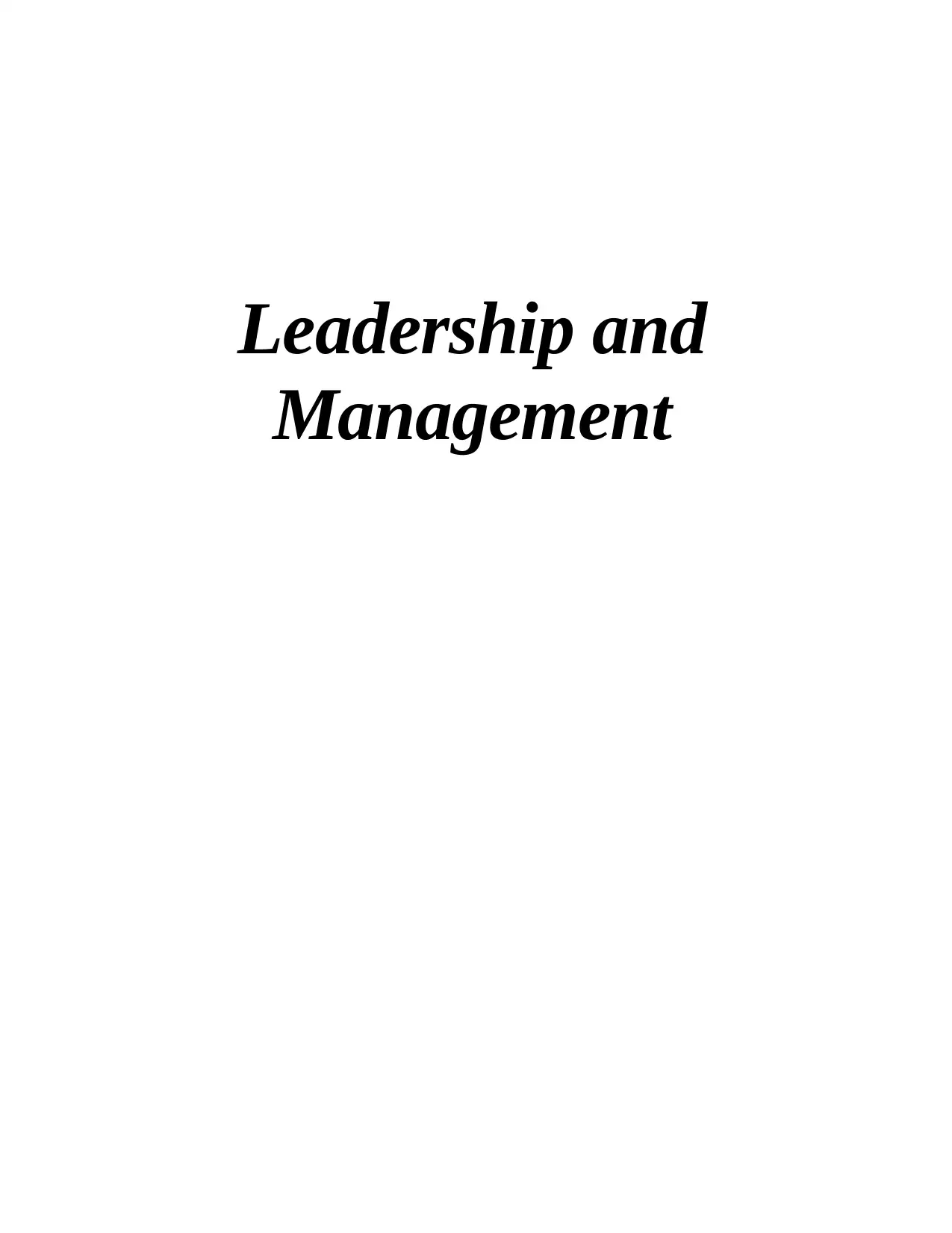
Leadership and
Management
Management
Paraphrase This Document
Need a fresh take? Get an instant paraphrase of this document with our AI Paraphraser
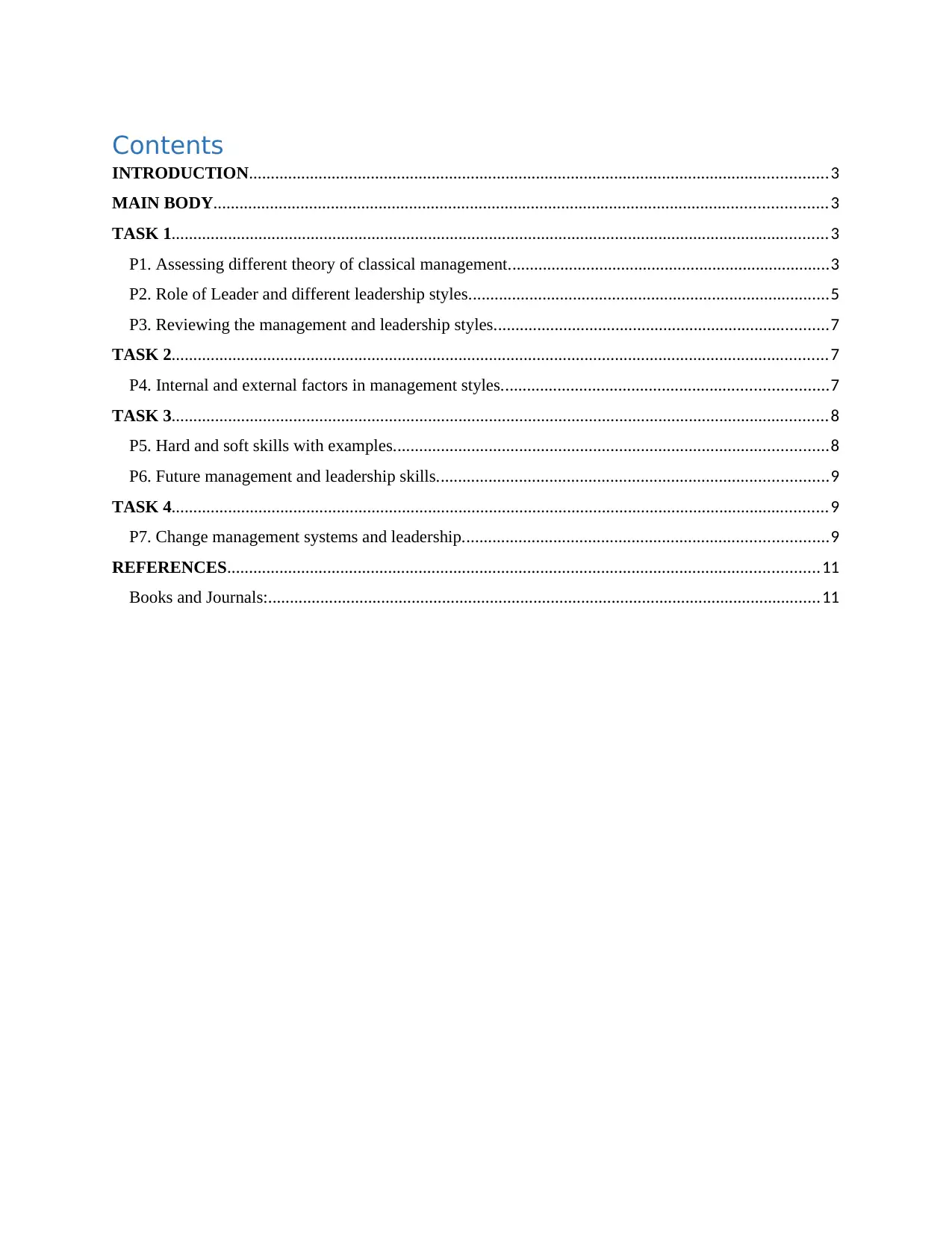
Contents
INTRODUCTION.....................................................................................................................................3
MAIN BODY.............................................................................................................................................3
TASK 1.......................................................................................................................................................3
P1. Assessing different theory of classical management..........................................................................3
P2. Role of Leader and different leadership styles...................................................................................5
P3. Reviewing the management and leadership styles.............................................................................7
TASK 2.......................................................................................................................................................7
P4. Internal and external factors in management styles...........................................................................7
TASK 3.......................................................................................................................................................8
P5. Hard and soft skills with examples....................................................................................................8
P6. Future management and leadership skills..........................................................................................9
TASK 4.......................................................................................................................................................9
P7. Change management systems and leadership....................................................................................9
REFERENCES........................................................................................................................................11
Books and Journals:...............................................................................................................................11
INTRODUCTION.....................................................................................................................................3
MAIN BODY.............................................................................................................................................3
TASK 1.......................................................................................................................................................3
P1. Assessing different theory of classical management..........................................................................3
P2. Role of Leader and different leadership styles...................................................................................5
P3. Reviewing the management and leadership styles.............................................................................7
TASK 2.......................................................................................................................................................7
P4. Internal and external factors in management styles...........................................................................7
TASK 3.......................................................................................................................................................8
P5. Hard and soft skills with examples....................................................................................................8
P6. Future management and leadership skills..........................................................................................9
TASK 4.......................................................................................................................................................9
P7. Change management systems and leadership....................................................................................9
REFERENCES........................................................................................................................................11
Books and Journals:...............................................................................................................................11
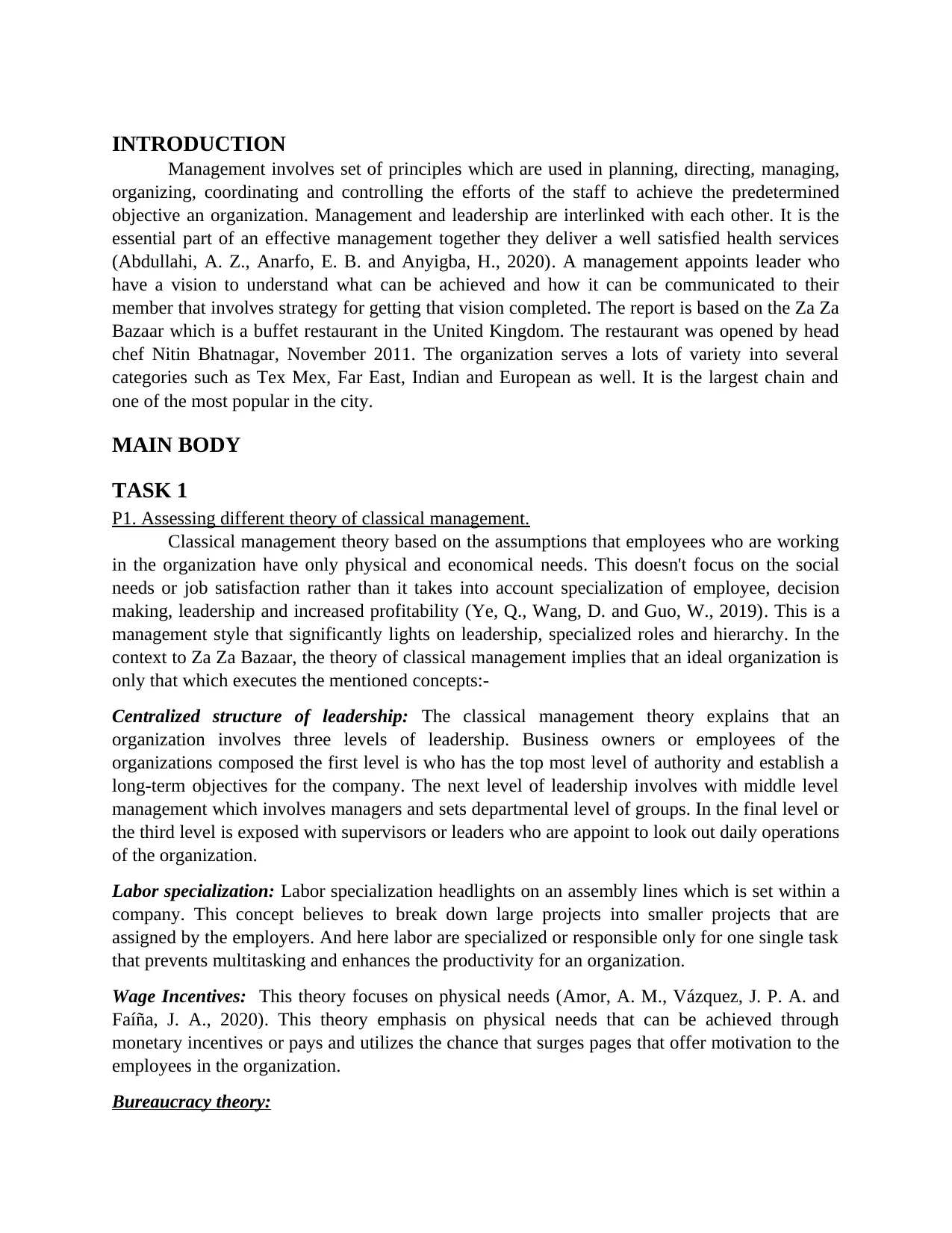
INTRODUCTION
Management involves set of principles which are used in planning, directing, managing,
organizing, coordinating and controlling the efforts of the staff to achieve the predetermined
objective an organization. Management and leadership are interlinked with each other. It is the
essential part of an effective management together they deliver a well satisfied health services
(Abdullahi, A. Z., Anarfo, E. B. and Anyigba, H., 2020). A management appoints leader who
have a vision to understand what can be achieved and how it can be communicated to their
member that involves strategy for getting that vision completed. The report is based on the Za Za
Bazaar which is a buffet restaurant in the United Kingdom. The restaurant was opened by head
chef Nitin Bhatnagar, November 2011. The organization serves a lots of variety into several
categories such as Tex Mex, Far East, Indian and European as well. It is the largest chain and
one of the most popular in the city.
MAIN BODY
TASK 1
P1. Assessing different theory of classical management.
Classical management theory based on the assumptions that employees who are working
in the organization have only physical and economical needs. This doesn't focus on the social
needs or job satisfaction rather than it takes into account specialization of employee, decision
making, leadership and increased profitability (Ye, Q., Wang, D. and Guo, W., 2019). This is a
management style that significantly lights on leadership, specialized roles and hierarchy. In the
context to Za Za Bazaar, the theory of classical management implies that an ideal organization is
only that which executes the mentioned concepts:-
Centralized structure of leadership: The classical management theory explains that an
organization involves three levels of leadership. Business owners or employees of the
organizations composed the first level is who has the top most level of authority and establish a
long-term objectives for the company. The next level of leadership involves with middle level
management which involves managers and sets departmental level of groups. In the final level or
the third level is exposed with supervisors or leaders who are appoint to look out daily operations
of the organization.
Labor specialization: Labor specialization headlights on an assembly lines which is set within a
company. This concept believes to break down large projects into smaller projects that are
assigned by the employers. And here labor are specialized or responsible only for one single task
that prevents multitasking and enhances the productivity for an organization.
Wage Incentives: This theory focuses on physical needs (Amor, A. M., Vázquez, J. P. A. and
Faíña, J. A., 2020). This theory emphasis on physical needs that can be achieved through
monetary incentives or pays and utilizes the chance that surges pages that offer motivation to the
employees in the organization.
Bureaucracy theory:
Management involves set of principles which are used in planning, directing, managing,
organizing, coordinating and controlling the efforts of the staff to achieve the predetermined
objective an organization. Management and leadership are interlinked with each other. It is the
essential part of an effective management together they deliver a well satisfied health services
(Abdullahi, A. Z., Anarfo, E. B. and Anyigba, H., 2020). A management appoints leader who
have a vision to understand what can be achieved and how it can be communicated to their
member that involves strategy for getting that vision completed. The report is based on the Za Za
Bazaar which is a buffet restaurant in the United Kingdom. The restaurant was opened by head
chef Nitin Bhatnagar, November 2011. The organization serves a lots of variety into several
categories such as Tex Mex, Far East, Indian and European as well. It is the largest chain and
one of the most popular in the city.
MAIN BODY
TASK 1
P1. Assessing different theory of classical management.
Classical management theory based on the assumptions that employees who are working
in the organization have only physical and economical needs. This doesn't focus on the social
needs or job satisfaction rather than it takes into account specialization of employee, decision
making, leadership and increased profitability (Ye, Q., Wang, D. and Guo, W., 2019). This is a
management style that significantly lights on leadership, specialized roles and hierarchy. In the
context to Za Za Bazaar, the theory of classical management implies that an ideal organization is
only that which executes the mentioned concepts:-
Centralized structure of leadership: The classical management theory explains that an
organization involves three levels of leadership. Business owners or employees of the
organizations composed the first level is who has the top most level of authority and establish a
long-term objectives for the company. The next level of leadership involves with middle level
management which involves managers and sets departmental level of groups. In the final level or
the third level is exposed with supervisors or leaders who are appoint to look out daily operations
of the organization.
Labor specialization: Labor specialization headlights on an assembly lines which is set within a
company. This concept believes to break down large projects into smaller projects that are
assigned by the employers. And here labor are specialized or responsible only for one single task
that prevents multitasking and enhances the productivity for an organization.
Wage Incentives: This theory focuses on physical needs (Amor, A. M., Vázquez, J. P. A. and
Faíña, J. A., 2020). This theory emphasis on physical needs that can be achieved through
monetary incentives or pays and utilizes the chance that surges pages that offer motivation to the
employees in the organization.
Bureaucracy theory:
⊘ This is a preview!⊘
Do you want full access?
Subscribe today to unlock all pages.

Trusted by 1+ million students worldwide
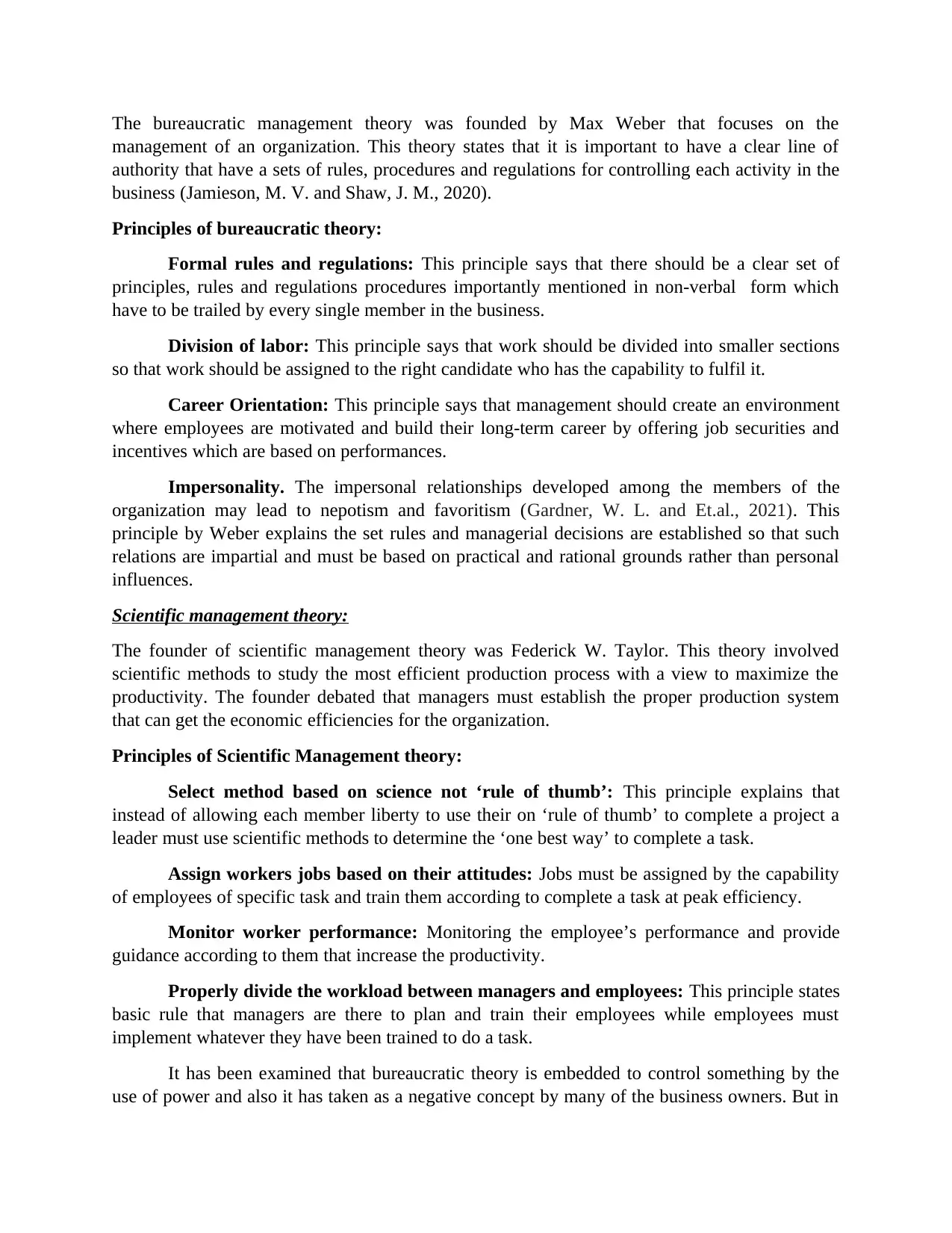
The bureaucratic management theory was founded by Max Weber that focuses on the
management of an organization. This theory states that it is important to have a clear line of
authority that have a sets of rules, procedures and regulations for controlling each activity in the
business (Jamieson, M. V. and Shaw, J. M., 2020).
Principles of bureaucratic theory:
Formal rules and regulations: This principle says that there should be a clear set of
principles, rules and regulations procedures importantly mentioned in non-verbal form which
have to be trailed by every single member in the business.
Division of labor: This principle says that work should be divided into smaller sections
so that work should be assigned to the right candidate who has the capability to fulfil it.
Career Orientation: This principle says that management should create an environment
where employees are motivated and build their long-term career by offering job securities and
incentives which are based on performances.
Impersonality. The impersonal relationships developed among the members of the
organization may lead to nepotism and favoritism (Gardner, W. L. and Et.al., 2021). This
principle by Weber explains the set rules and managerial decisions are established so that such
relations are impartial and must be based on practical and rational grounds rather than personal
influences.
Scientific management theory:
The founder of scientific management theory was Federick W. Taylor. This theory involved
scientific methods to study the most efficient production process with a view to maximize the
productivity. The founder debated that managers must establish the proper production system
that can get the economic efficiencies for the organization.
Principles of Scientific Management theory:
Select method based on science not ‘rule of thumb’: This principle explains that
instead of allowing each member liberty to use their on ‘rule of thumb’ to complete a project a
leader must use scientific methods to determine the ‘one best way’ to complete a task.
Assign workers jobs based on their attitudes: Jobs must be assigned by the capability
of employees of specific task and train them according to complete a task at peak efficiency.
Monitor worker performance: Monitoring the employee’s performance and provide
guidance according to them that increase the productivity.
Properly divide the workload between managers and employees: This principle states
basic rule that managers are there to plan and train their employees while employees must
implement whatever they have been trained to do a task.
It has been examined that bureaucratic theory is embedded to control something by the
use of power and also it has taken as a negative concept by many of the business owners. But in
management of an organization. This theory states that it is important to have a clear line of
authority that have a sets of rules, procedures and regulations for controlling each activity in the
business (Jamieson, M. V. and Shaw, J. M., 2020).
Principles of bureaucratic theory:
Formal rules and regulations: This principle says that there should be a clear set of
principles, rules and regulations procedures importantly mentioned in non-verbal form which
have to be trailed by every single member in the business.
Division of labor: This principle says that work should be divided into smaller sections
so that work should be assigned to the right candidate who has the capability to fulfil it.
Career Orientation: This principle says that management should create an environment
where employees are motivated and build their long-term career by offering job securities and
incentives which are based on performances.
Impersonality. The impersonal relationships developed among the members of the
organization may lead to nepotism and favoritism (Gardner, W. L. and Et.al., 2021). This
principle by Weber explains the set rules and managerial decisions are established so that such
relations are impartial and must be based on practical and rational grounds rather than personal
influences.
Scientific management theory:
The founder of scientific management theory was Federick W. Taylor. This theory involved
scientific methods to study the most efficient production process with a view to maximize the
productivity. The founder debated that managers must establish the proper production system
that can get the economic efficiencies for the organization.
Principles of Scientific Management theory:
Select method based on science not ‘rule of thumb’: This principle explains that
instead of allowing each member liberty to use their on ‘rule of thumb’ to complete a project a
leader must use scientific methods to determine the ‘one best way’ to complete a task.
Assign workers jobs based on their attitudes: Jobs must be assigned by the capability
of employees of specific task and train them according to complete a task at peak efficiency.
Monitor worker performance: Monitoring the employee’s performance and provide
guidance according to them that increase the productivity.
Properly divide the workload between managers and employees: This principle states
basic rule that managers are there to plan and train their employees while employees must
implement whatever they have been trained to do a task.
It has been examined that bureaucratic theory is embedded to control something by the
use of power and also it has taken as a negative concept by many of the business owners. But in
Paraphrase This Document
Need a fresh take? Get an instant paraphrase of this document with our AI Paraphraser
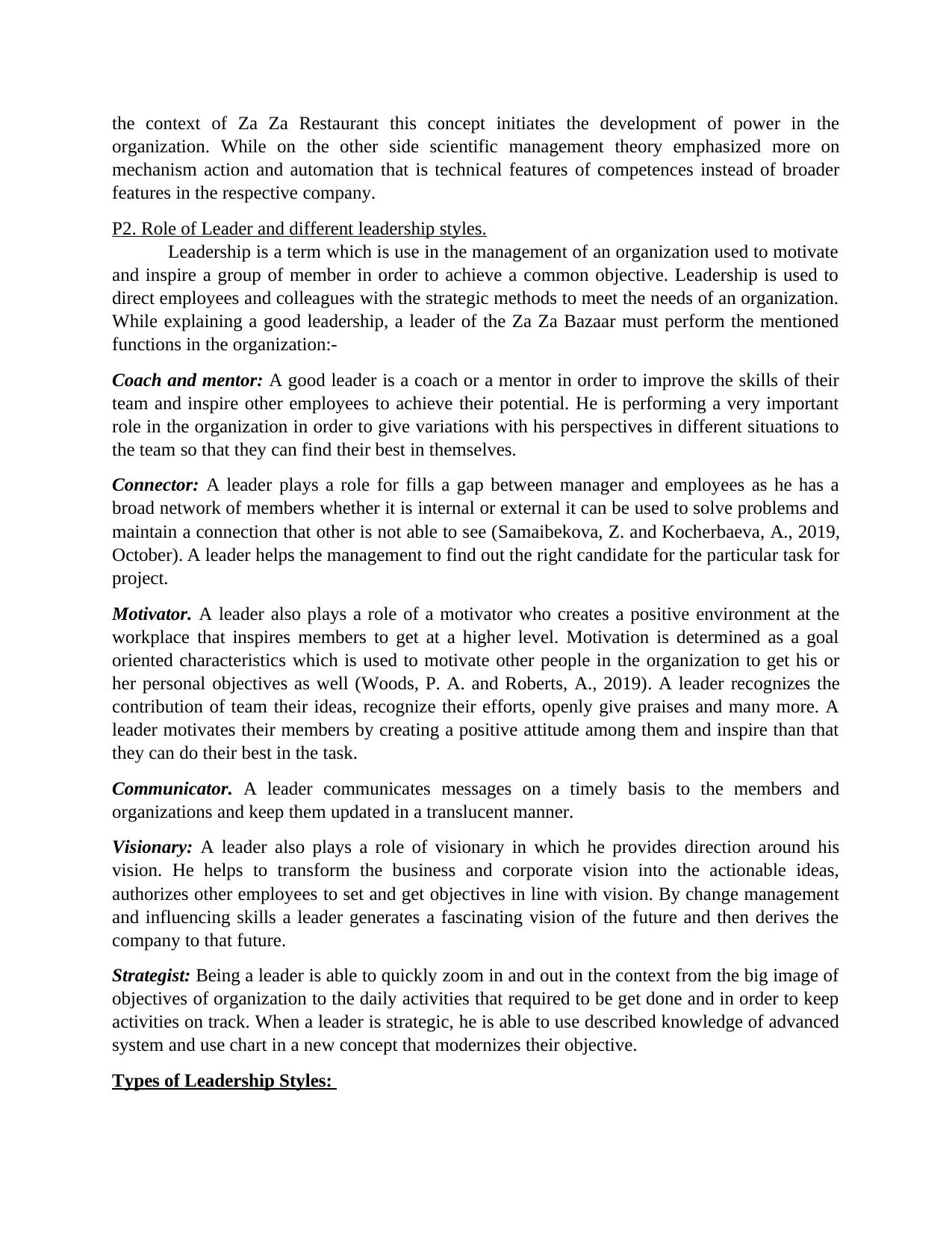
the context of Za Za Restaurant this concept initiates the development of power in the
organization. While on the other side scientific management theory emphasized more on
mechanism action and automation that is technical features of competences instead of broader
features in the respective company.
P2. Role of Leader and different leadership styles.
Leadership is a term which is use in the management of an organization used to motivate
and inspire a group of member in order to achieve a common objective. Leadership is used to
direct employees and colleagues with the strategic methods to meet the needs of an organization.
While explaining a good leadership, a leader of the Za Za Bazaar must perform the mentioned
functions in the organization:-
Coach and mentor: A good leader is a coach or a mentor in order to improve the skills of their
team and inspire other employees to achieve their potential. He is performing a very important
role in the organization in order to give variations with his perspectives in different situations to
the team so that they can find their best in themselves.
Connector: A leader plays a role for fills a gap between manager and employees as he has a
broad network of members whether it is internal or external it can be used to solve problems and
maintain a connection that other is not able to see (Samaibekova, Z. and Kocherbaeva, A., 2019,
October). A leader helps the management to find out the right candidate for the particular task for
project.
Motivator. A leader also plays a role of a motivator who creates a positive environment at the
workplace that inspires members to get at a higher level. Motivation is determined as a goal
oriented characteristics which is used to motivate other people in the organization to get his or
her personal objectives as well (Woods, P. A. and Roberts, A., 2019). A leader recognizes the
contribution of team their ideas, recognize their efforts, openly give praises and many more. A
leader motivates their members by creating a positive attitude among them and inspire than that
they can do their best in the task.
Communicator. A leader communicates messages on a timely basis to the members and
organizations and keep them updated in a translucent manner.
Visionary: A leader also plays a role of visionary in which he provides direction around his
vision. He helps to transform the business and corporate vision into the actionable ideas,
authorizes other employees to set and get objectives in line with vision. By change management
and influencing skills a leader generates a fascinating vision of the future and then derives the
company to that future.
Strategist: Being a leader is able to quickly zoom in and out in the context from the big image of
objectives of organization to the daily activities that required to be get done and in order to keep
activities on track. When a leader is strategic, he is able to use described knowledge of advanced
system and use chart in a new concept that modernizes their objective.
Types of Leadership Styles:
organization. While on the other side scientific management theory emphasized more on
mechanism action and automation that is technical features of competences instead of broader
features in the respective company.
P2. Role of Leader and different leadership styles.
Leadership is a term which is use in the management of an organization used to motivate
and inspire a group of member in order to achieve a common objective. Leadership is used to
direct employees and colleagues with the strategic methods to meet the needs of an organization.
While explaining a good leadership, a leader of the Za Za Bazaar must perform the mentioned
functions in the organization:-
Coach and mentor: A good leader is a coach or a mentor in order to improve the skills of their
team and inspire other employees to achieve their potential. He is performing a very important
role in the organization in order to give variations with his perspectives in different situations to
the team so that they can find their best in themselves.
Connector: A leader plays a role for fills a gap between manager and employees as he has a
broad network of members whether it is internal or external it can be used to solve problems and
maintain a connection that other is not able to see (Samaibekova, Z. and Kocherbaeva, A., 2019,
October). A leader helps the management to find out the right candidate for the particular task for
project.
Motivator. A leader also plays a role of a motivator who creates a positive environment at the
workplace that inspires members to get at a higher level. Motivation is determined as a goal
oriented characteristics which is used to motivate other people in the organization to get his or
her personal objectives as well (Woods, P. A. and Roberts, A., 2019). A leader recognizes the
contribution of team their ideas, recognize their efforts, openly give praises and many more. A
leader motivates their members by creating a positive attitude among them and inspire than that
they can do their best in the task.
Communicator. A leader communicates messages on a timely basis to the members and
organizations and keep them updated in a translucent manner.
Visionary: A leader also plays a role of visionary in which he provides direction around his
vision. He helps to transform the business and corporate vision into the actionable ideas,
authorizes other employees to set and get objectives in line with vision. By change management
and influencing skills a leader generates a fascinating vision of the future and then derives the
company to that future.
Strategist: Being a leader is able to quickly zoom in and out in the context from the big image of
objectives of organization to the daily activities that required to be get done and in order to keep
activities on track. When a leader is strategic, he is able to use described knowledge of advanced
system and use chart in a new concept that modernizes their objective.
Types of Leadership Styles:
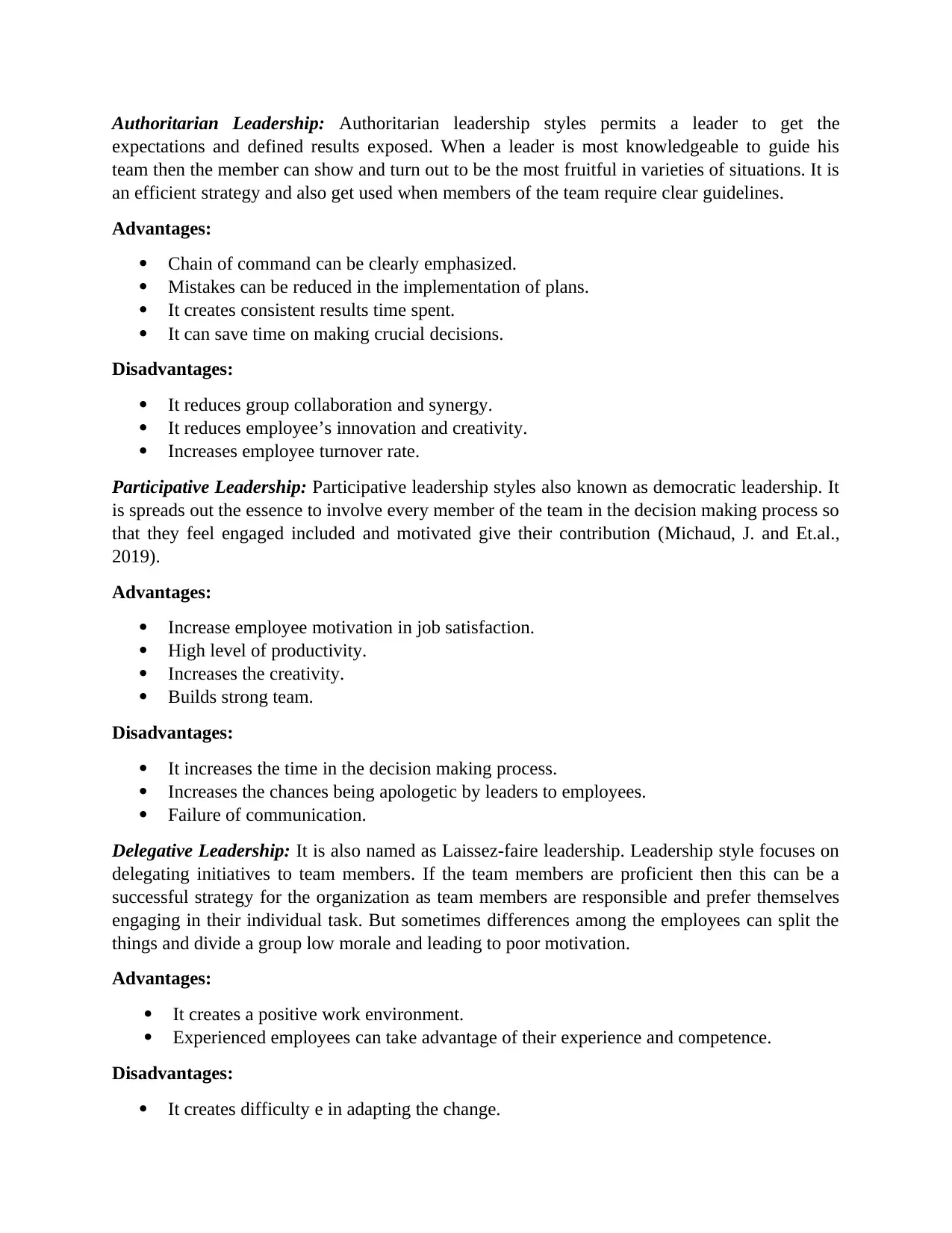
Authoritarian Leadership: Authoritarian leadership styles permits a leader to get the
expectations and defined results exposed. When a leader is most knowledgeable to guide his
team then the member can show and turn out to be the most fruitful in varieties of situations. It is
an efficient strategy and also get used when members of the team require clear guidelines.
Advantages:
Chain of command can be clearly emphasized.
Mistakes can be reduced in the implementation of plans.
It creates consistent results time spent.
It can save time on making crucial decisions.
Disadvantages:
It reduces group collaboration and synergy.
It reduces employee’s innovation and creativity.
Increases employee turnover rate.
Participative Leadership: Participative leadership styles also known as democratic leadership. It
is spreads out the essence to involve every member of the team in the decision making process so
that they feel engaged included and motivated give their contribution (Michaud, J. and Et.al.,
2019).
Advantages:
Increase employee motivation in job satisfaction.
High level of productivity.
Increases the creativity.
Builds strong team.
Disadvantages:
It increases the time in the decision making process.
Increases the chances being apologetic by leaders to employees.
Failure of communication.
Delegative Leadership: It is also named as Laissez-faire leadership. Leadership style focuses on
delegating initiatives to team members. If the team members are proficient then this can be a
successful strategy for the organization as team members are responsible and prefer themselves
engaging in their individual task. But sometimes differences among the employees can split the
things and divide a group low morale and leading to poor motivation.
Advantages:
It creates a positive work environment.
Experienced employees can take advantage of their experience and competence.
Disadvantages:
It creates difficulty e in adapting the change.
expectations and defined results exposed. When a leader is most knowledgeable to guide his
team then the member can show and turn out to be the most fruitful in varieties of situations. It is
an efficient strategy and also get used when members of the team require clear guidelines.
Advantages:
Chain of command can be clearly emphasized.
Mistakes can be reduced in the implementation of plans.
It creates consistent results time spent.
It can save time on making crucial decisions.
Disadvantages:
It reduces group collaboration and synergy.
It reduces employee’s innovation and creativity.
Increases employee turnover rate.
Participative Leadership: Participative leadership styles also known as democratic leadership. It
is spreads out the essence to involve every member of the team in the decision making process so
that they feel engaged included and motivated give their contribution (Michaud, J. and Et.al.,
2019).
Advantages:
Increase employee motivation in job satisfaction.
High level of productivity.
Increases the creativity.
Builds strong team.
Disadvantages:
It increases the time in the decision making process.
Increases the chances being apologetic by leaders to employees.
Failure of communication.
Delegative Leadership: It is also named as Laissez-faire leadership. Leadership style focuses on
delegating initiatives to team members. If the team members are proficient then this can be a
successful strategy for the organization as team members are responsible and prefer themselves
engaging in their individual task. But sometimes differences among the employees can split the
things and divide a group low morale and leading to poor motivation.
Advantages:
It creates a positive work environment.
Experienced employees can take advantage of their experience and competence.
Disadvantages:
It creates difficulty e in adapting the change.
⊘ This is a preview!⊘
Do you want full access?
Subscribe today to unlock all pages.

Trusted by 1+ million students worldwide

Responsibility for commands are not properly defined.
P3. Reviewing the management and leadership styles.
It has been analyzed that bureaucracy is associated with apathy, excessive paperwork,
inflexibility and unresponsiveness. Fayol was concerned with how employees are managed and
contribute to the respective organization named Za Za Restaurant. The theory when apply in the
organization, leaders over there felt that it makes employees satisfied and motivated. Scientific
theory of management helps the Za Za Restaurant to analyze that their flow of work improvise
with economic efficiencies especially concerned with labour productivity. This theory give
emphasis to the almost every industrial business operations throughout the globe. In the context
to Za Za Groups this is a theory which is used to examining and evaluating the process of
organization in order to maximize is the performance (Pitelis, C. N. and Wagner, J. D., 2019). It
provides various tool to the management such as functional foremanship, standardization and
simplification of work, fatigue study and many more. When a manager of the Za Za Groups
understands what type of leadership approach can be used, can work accordingly to improve the
communication between employees and the management a good leader can be able to inspire and
motivate the staff and skill and encourage to meet the objectives and designs of the respective
organization. There are various types of leadership approaches or styles are mentioned earlier
such as authoritarian leadership, participative leadership or delegative leadership. By using such
type of leadership style a leader will be able to handle the challenges more effectively with their
team members. One of the great leadership style is delegative leadership that offers support and
resources for team members whenever they require. It is a quite effective leadership style that
builds trust among team members and a leader might able know who are good at work or a
specialized at specific project.
TASK 2
P4. Internal and external factors in management styles.
There are many aspects that influences the type of management that will work best for
the organizations. Some of the internal and external factors are mentioned below:
Internal Factors:
Personality: It is one of the factor that considers the leadership style when person or leader is in
charge of a team. Combining individual’s basic nature with a specific method of management is
most often effective because it will be comfortable for the leader with it.
Company culture: The Company’s culture is also influencing the leadership style. If the culture
of the organization is strong that motivates and well trained their employees. The leader or
manager can adopt delegative style of leadership. This method is used to inspire but not to
micromanage or even to spend much time to overlook the projects.
Spiritual experiences: A charismatic leader can influence the employees with power or
experiences even the relationship between a leader and staff is corporate one. Those leaders who
have the charismatic characteristic in his leadership style will be able to inspire their followers
with the primary attribute.
P3. Reviewing the management and leadership styles.
It has been analyzed that bureaucracy is associated with apathy, excessive paperwork,
inflexibility and unresponsiveness. Fayol was concerned with how employees are managed and
contribute to the respective organization named Za Za Restaurant. The theory when apply in the
organization, leaders over there felt that it makes employees satisfied and motivated. Scientific
theory of management helps the Za Za Restaurant to analyze that their flow of work improvise
with economic efficiencies especially concerned with labour productivity. This theory give
emphasis to the almost every industrial business operations throughout the globe. In the context
to Za Za Groups this is a theory which is used to examining and evaluating the process of
organization in order to maximize is the performance (Pitelis, C. N. and Wagner, J. D., 2019). It
provides various tool to the management such as functional foremanship, standardization and
simplification of work, fatigue study and many more. When a manager of the Za Za Groups
understands what type of leadership approach can be used, can work accordingly to improve the
communication between employees and the management a good leader can be able to inspire and
motivate the staff and skill and encourage to meet the objectives and designs of the respective
organization. There are various types of leadership approaches or styles are mentioned earlier
such as authoritarian leadership, participative leadership or delegative leadership. By using such
type of leadership style a leader will be able to handle the challenges more effectively with their
team members. One of the great leadership style is delegative leadership that offers support and
resources for team members whenever they require. It is a quite effective leadership style that
builds trust among team members and a leader might able know who are good at work or a
specialized at specific project.
TASK 2
P4. Internal and external factors in management styles.
There are many aspects that influences the type of management that will work best for
the organizations. Some of the internal and external factors are mentioned below:
Internal Factors:
Personality: It is one of the factor that considers the leadership style when person or leader is in
charge of a team. Combining individual’s basic nature with a specific method of management is
most often effective because it will be comfortable for the leader with it.
Company culture: The Company’s culture is also influencing the leadership style. If the culture
of the organization is strong that motivates and well trained their employees. The leader or
manager can adopt delegative style of leadership. This method is used to inspire but not to
micromanage or even to spend much time to overlook the projects.
Spiritual experiences: A charismatic leader can influence the employees with power or
experiences even the relationship between a leader and staff is corporate one. Those leaders who
have the charismatic characteristic in his leadership style will be able to inspire their followers
with the primary attribute.
Paraphrase This Document
Need a fresh take? Get an instant paraphrase of this document with our AI Paraphraser
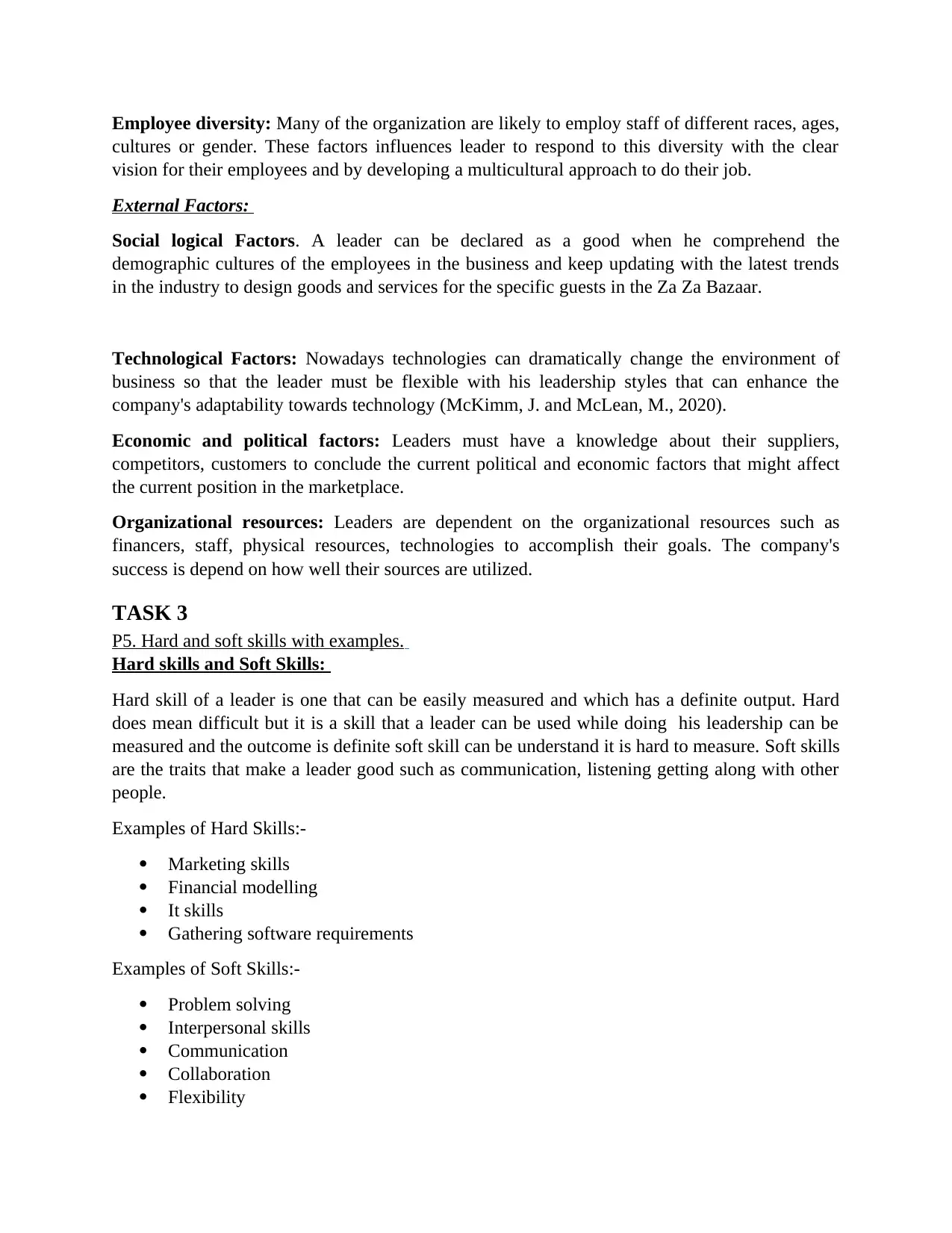
Employee diversity: Many of the organization are likely to employ staff of different races, ages,
cultures or gender. These factors influences leader to respond to this diversity with the clear
vision for their employees and by developing a multicultural approach to do their job.
External Factors:
Social logical Factors. A leader can be declared as a good when he comprehend the
demographic cultures of the employees in the business and keep updating with the latest trends
in the industry to design goods and services for the specific guests in the Za Za Bazaar.
Technological Factors: Nowadays technologies can dramatically change the environment of
business so that the leader must be flexible with his leadership styles that can enhance the
company's adaptability towards technology (McKimm, J. and McLean, M., 2020).
Economic and political factors: Leaders must have a knowledge about their suppliers,
competitors, customers to conclude the current political and economic factors that might affect
the current position in the marketplace.
Organizational resources: Leaders are dependent on the organizational resources such as
financers, staff, physical resources, technologies to accomplish their goals. The company's
success is depend on how well their sources are utilized.
TASK 3
P5. Hard and soft skills with examples.
Hard skills and Soft Skills:
Hard skill of a leader is one that can be easily measured and which has a definite output. Hard
does mean difficult but it is a skill that a leader can be used while doing his leadership can be
measured and the outcome is definite soft skill can be understand it is hard to measure. Soft skills
are the traits that make a leader good such as communication, listening getting along with other
people.
Examples of Hard Skills:-
Marketing skills
Financial modelling
It skills
Gathering software requirements
Examples of Soft Skills:-
Problem solving
Interpersonal skills
Communication
Collaboration
Flexibility
cultures or gender. These factors influences leader to respond to this diversity with the clear
vision for their employees and by developing a multicultural approach to do their job.
External Factors:
Social logical Factors. A leader can be declared as a good when he comprehend the
demographic cultures of the employees in the business and keep updating with the latest trends
in the industry to design goods and services for the specific guests in the Za Za Bazaar.
Technological Factors: Nowadays technologies can dramatically change the environment of
business so that the leader must be flexible with his leadership styles that can enhance the
company's adaptability towards technology (McKimm, J. and McLean, M., 2020).
Economic and political factors: Leaders must have a knowledge about their suppliers,
competitors, customers to conclude the current political and economic factors that might affect
the current position in the marketplace.
Organizational resources: Leaders are dependent on the organizational resources such as
financers, staff, physical resources, technologies to accomplish their goals. The company's
success is depend on how well their sources are utilized.
TASK 3
P5. Hard and soft skills with examples.
Hard skills and Soft Skills:
Hard skill of a leader is one that can be easily measured and which has a definite output. Hard
does mean difficult but it is a skill that a leader can be used while doing his leadership can be
measured and the outcome is definite soft skill can be understand it is hard to measure. Soft skills
are the traits that make a leader good such as communication, listening getting along with other
people.
Examples of Hard Skills:-
Marketing skills
Financial modelling
It skills
Gathering software requirements
Examples of Soft Skills:-
Problem solving
Interpersonal skills
Communication
Collaboration
Flexibility
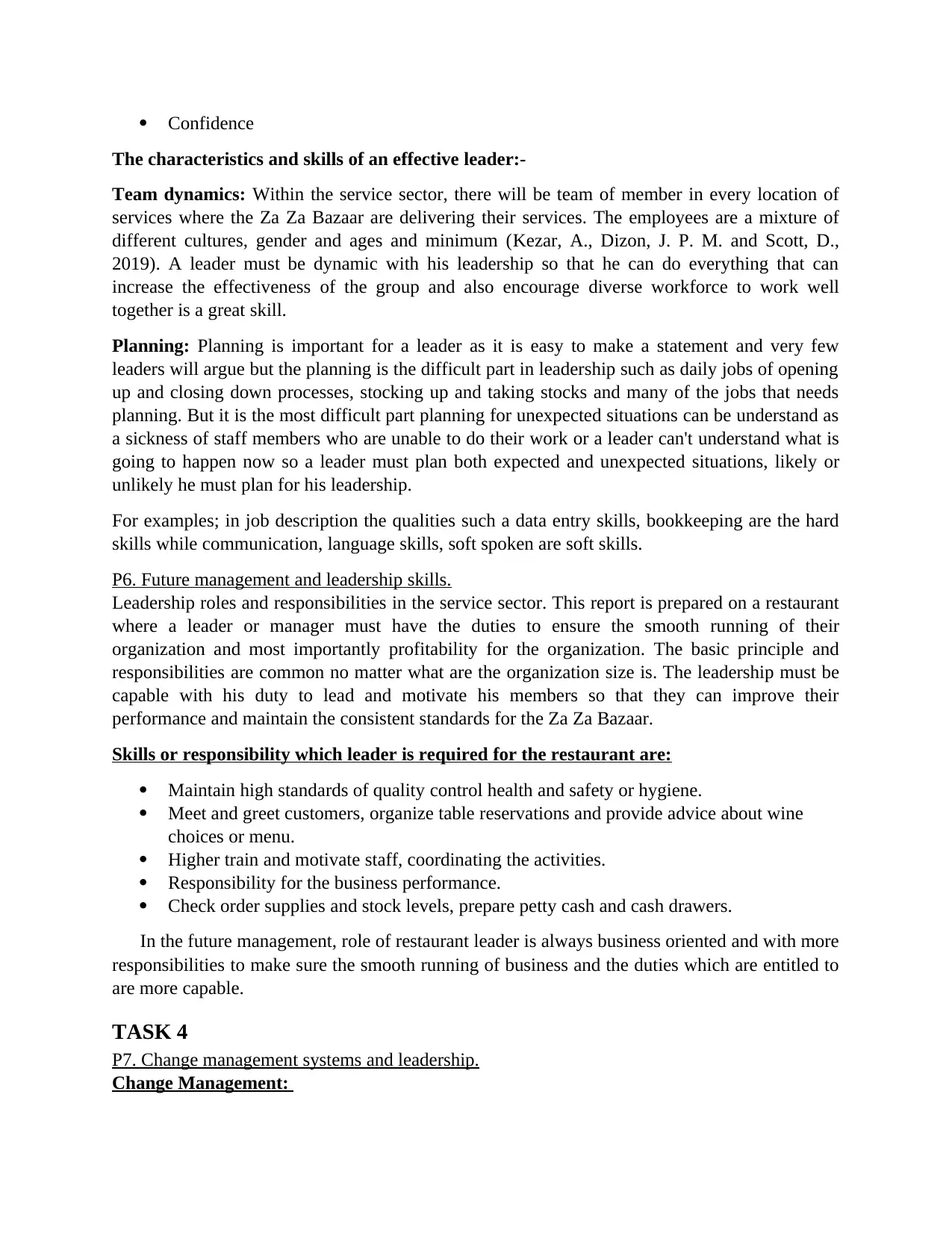
Confidence
The characteristics and skills of an effective leader:-
Team dynamics: Within the service sector, there will be team of member in every location of
services where the Za Za Bazaar are delivering their services. The employees are a mixture of
different cultures, gender and ages and minimum (Kezar, A., Dizon, J. P. M. and Scott, D.,
2019). A leader must be dynamic with his leadership so that he can do everything that can
increase the effectiveness of the group and also encourage diverse workforce to work well
together is a great skill.
Planning: Planning is important for a leader as it is easy to make a statement and very few
leaders will argue but the planning is the difficult part in leadership such as daily jobs of opening
up and closing down processes, stocking up and taking stocks and many of the jobs that needs
planning. But it is the most difficult part planning for unexpected situations can be understand as
a sickness of staff members who are unable to do their work or a leader can't understand what is
going to happen now so a leader must plan both expected and unexpected situations, likely or
unlikely he must plan for his leadership.
For examples; in job description the qualities such a data entry skills, bookkeeping are the hard
skills while communication, language skills, soft spoken are soft skills.
P6. Future management and leadership skills.
Leadership roles and responsibilities in the service sector. This report is prepared on a restaurant
where a leader or manager must have the duties to ensure the smooth running of their
organization and most importantly profitability for the organization. The basic principle and
responsibilities are common no matter what are the organization size is. The leadership must be
capable with his duty to lead and motivate his members so that they can improve their
performance and maintain the consistent standards for the Za Za Bazaar.
Skills or responsibility which leader is required for the restaurant are:
Maintain high standards of quality control health and safety or hygiene.
Meet and greet customers, organize table reservations and provide advice about wine
choices or menu.
Higher train and motivate staff, coordinating the activities.
Responsibility for the business performance.
Check order supplies and stock levels, prepare petty cash and cash drawers.
In the future management, role of restaurant leader is always business oriented and with more
responsibilities to make sure the smooth running of business and the duties which are entitled to
are more capable.
TASK 4
P7. Change management systems and leadership.
Change Management:
The characteristics and skills of an effective leader:-
Team dynamics: Within the service sector, there will be team of member in every location of
services where the Za Za Bazaar are delivering their services. The employees are a mixture of
different cultures, gender and ages and minimum (Kezar, A., Dizon, J. P. M. and Scott, D.,
2019). A leader must be dynamic with his leadership so that he can do everything that can
increase the effectiveness of the group and also encourage diverse workforce to work well
together is a great skill.
Planning: Planning is important for a leader as it is easy to make a statement and very few
leaders will argue but the planning is the difficult part in leadership such as daily jobs of opening
up and closing down processes, stocking up and taking stocks and many of the jobs that needs
planning. But it is the most difficult part planning for unexpected situations can be understand as
a sickness of staff members who are unable to do their work or a leader can't understand what is
going to happen now so a leader must plan both expected and unexpected situations, likely or
unlikely he must plan for his leadership.
For examples; in job description the qualities such a data entry skills, bookkeeping are the hard
skills while communication, language skills, soft spoken are soft skills.
P6. Future management and leadership skills.
Leadership roles and responsibilities in the service sector. This report is prepared on a restaurant
where a leader or manager must have the duties to ensure the smooth running of their
organization and most importantly profitability for the organization. The basic principle and
responsibilities are common no matter what are the organization size is. The leadership must be
capable with his duty to lead and motivate his members so that they can improve their
performance and maintain the consistent standards for the Za Za Bazaar.
Skills or responsibility which leader is required for the restaurant are:
Maintain high standards of quality control health and safety or hygiene.
Meet and greet customers, organize table reservations and provide advice about wine
choices or menu.
Higher train and motivate staff, coordinating the activities.
Responsibility for the business performance.
Check order supplies and stock levels, prepare petty cash and cash drawers.
In the future management, role of restaurant leader is always business oriented and with more
responsibilities to make sure the smooth running of business and the duties which are entitled to
are more capable.
TASK 4
P7. Change management systems and leadership.
Change Management:
⊘ This is a preview!⊘
Do you want full access?
Subscribe today to unlock all pages.

Trusted by 1+ million students worldwide
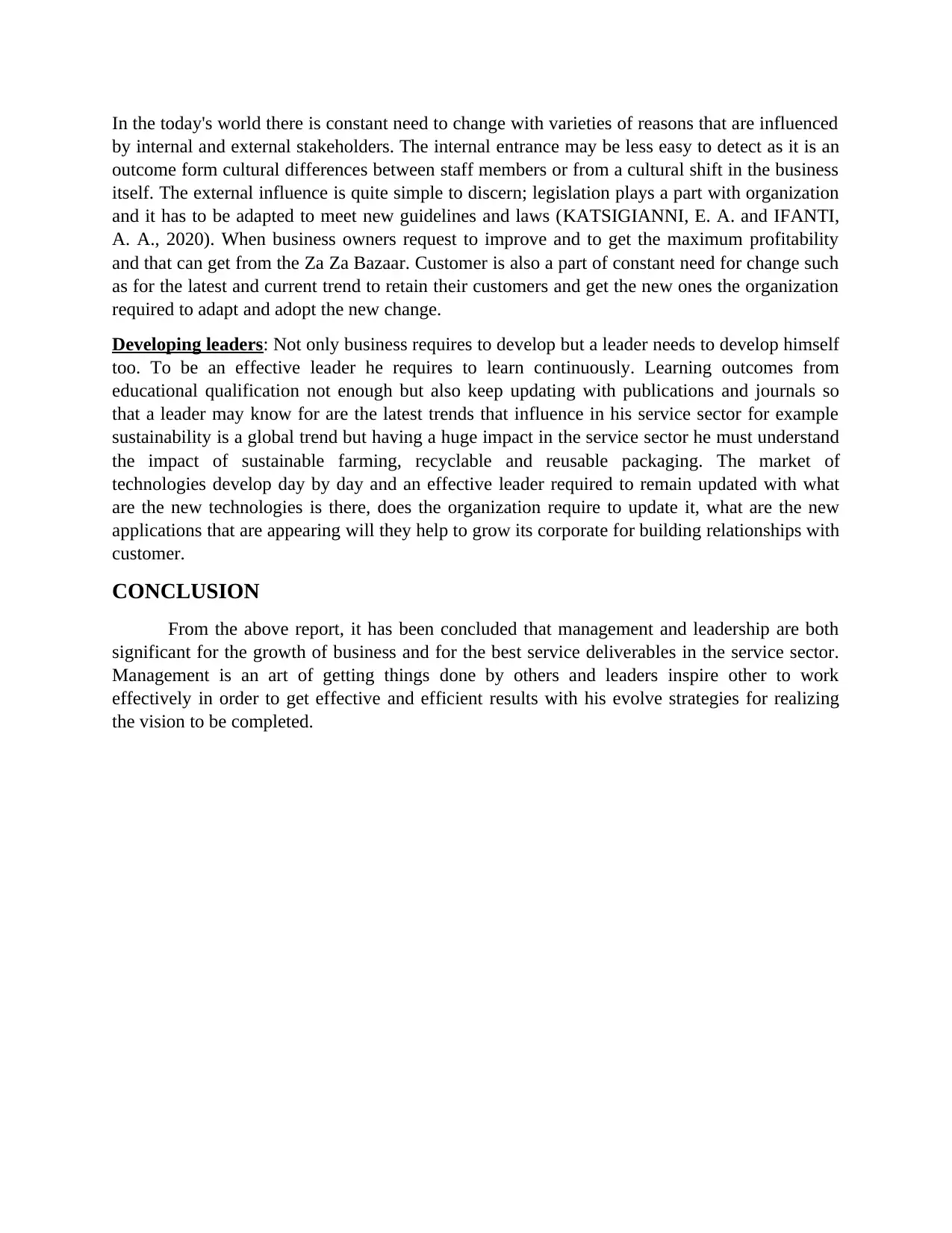
In the today's world there is constant need to change with varieties of reasons that are influenced
by internal and external stakeholders. The internal entrance may be less easy to detect as it is an
outcome form cultural differences between staff members or from a cultural shift in the business
itself. The external influence is quite simple to discern; legislation plays a part with organization
and it has to be adapted to meet new guidelines and laws (KATSIGIANNI, E. Α. and IFANTI,
A. A., 2020). When business owners request to improve and to get the maximum profitability
and that can get from the Za Za Bazaar. Customer is also a part of constant need for change such
as for the latest and current trend to retain their customers and get the new ones the organization
required to adapt and adopt the new change.
Developing leaders: Not only business requires to develop but a leader needs to develop himself
too. To be an effective leader he requires to learn continuously. Learning outcomes from
educational qualification not enough but also keep updating with publications and journals so
that a leader may know for are the latest trends that influence in his service sector for example
sustainability is a global trend but having a huge impact in the service sector he must understand
the impact of sustainable farming, recyclable and reusable packaging. The market of
technologies develop day by day and an effective leader required to remain updated with what
are the new technologies is there, does the organization require to update it, what are the new
applications that are appearing will they help to grow its corporate for building relationships with
customer.
CONCLUSION
From the above report, it has been concluded that management and leadership are both
significant for the growth of business and for the best service deliverables in the service sector.
Management is an art of getting things done by others and leaders inspire other to work
effectively in order to get effective and efficient results with his evolve strategies for realizing
the vision to be completed.
by internal and external stakeholders. The internal entrance may be less easy to detect as it is an
outcome form cultural differences between staff members or from a cultural shift in the business
itself. The external influence is quite simple to discern; legislation plays a part with organization
and it has to be adapted to meet new guidelines and laws (KATSIGIANNI, E. Α. and IFANTI,
A. A., 2020). When business owners request to improve and to get the maximum profitability
and that can get from the Za Za Bazaar. Customer is also a part of constant need for change such
as for the latest and current trend to retain their customers and get the new ones the organization
required to adapt and adopt the new change.
Developing leaders: Not only business requires to develop but a leader needs to develop himself
too. To be an effective leader he requires to learn continuously. Learning outcomes from
educational qualification not enough but also keep updating with publications and journals so
that a leader may know for are the latest trends that influence in his service sector for example
sustainability is a global trend but having a huge impact in the service sector he must understand
the impact of sustainable farming, recyclable and reusable packaging. The market of
technologies develop day by day and an effective leader required to remain updated with what
are the new technologies is there, does the organization require to update it, what are the new
applications that are appearing will they help to grow its corporate for building relationships with
customer.
CONCLUSION
From the above report, it has been concluded that management and leadership are both
significant for the growth of business and for the best service deliverables in the service sector.
Management is an art of getting things done by others and leaders inspire other to work
effectively in order to get effective and efficient results with his evolve strategies for realizing
the vision to be completed.
Paraphrase This Document
Need a fresh take? Get an instant paraphrase of this document with our AI Paraphraser
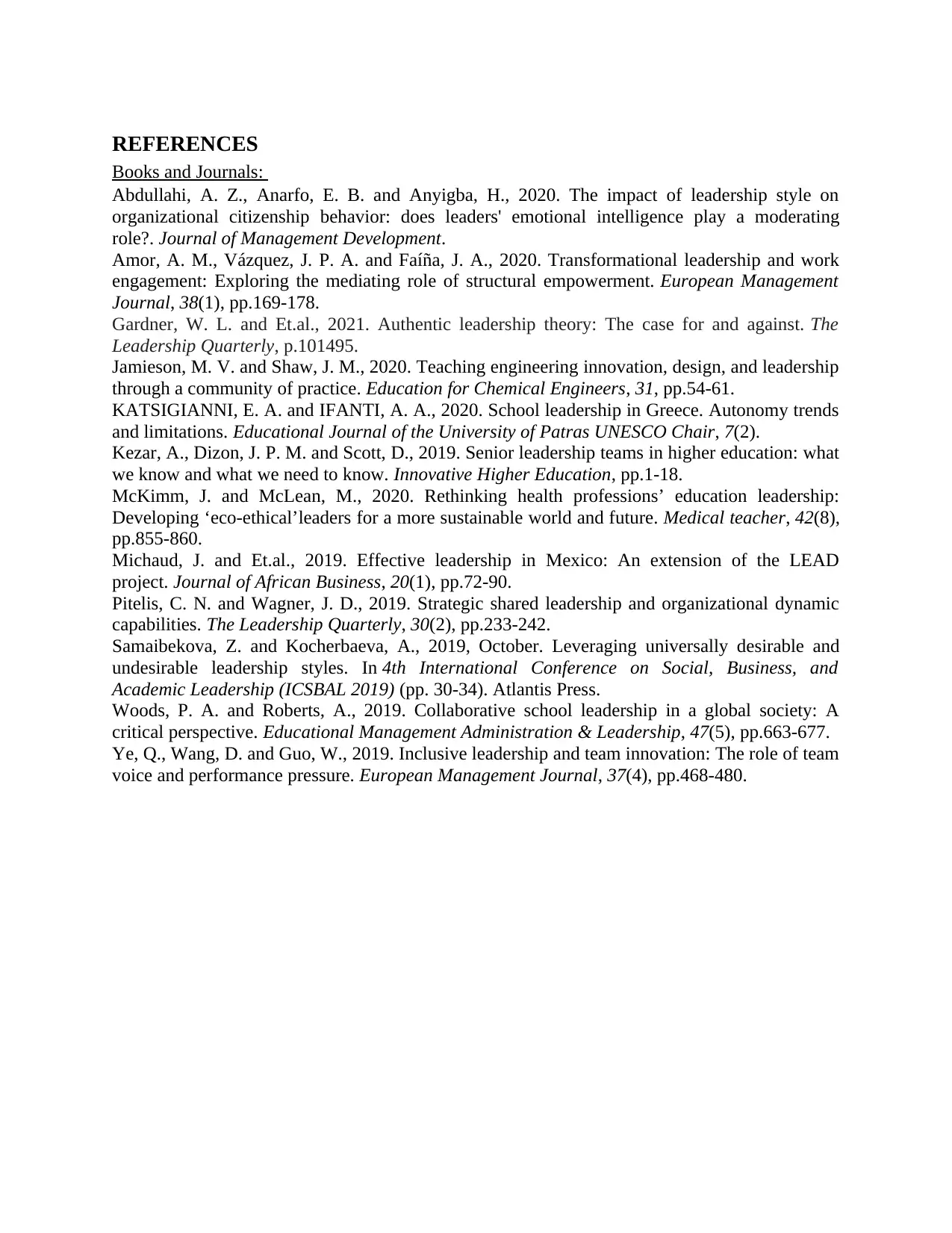
REFERENCES
Books and Journals:
Abdullahi, A. Z., Anarfo, E. B. and Anyigba, H., 2020. The impact of leadership style on
organizational citizenship behavior: does leaders' emotional intelligence play a moderating
role?. Journal of Management Development.
Amor, A. M., Vázquez, J. P. A. and Faíña, J. A., 2020. Transformational leadership and work
engagement: Exploring the mediating role of structural empowerment. European Management
Journal, 38(1), pp.169-178.
Gardner, W. L. and Et.al., 2021. Authentic leadership theory: The case for and against. The
Leadership Quarterly, p.101495.
Jamieson, M. V. and Shaw, J. M., 2020. Teaching engineering innovation, design, and leadership
through a community of practice. Education for Chemical Engineers, 31, pp.54-61.
KATSIGIANNI, E. Α. and IFANTI, A. A., 2020. School leadership in Greece. Autonomy trends
and limitations. Educational Journal of the University of Patras UNESCO Chair, 7(2).
Kezar, A., Dizon, J. P. M. and Scott, D., 2019. Senior leadership teams in higher education: what
we know and what we need to know. Innovative Higher Education, pp.1-18.
McKimm, J. and McLean, M., 2020. Rethinking health professions’ education leadership:
Developing ‘eco-ethical’leaders for a more sustainable world and future. Medical teacher, 42(8),
pp.855-860.
Michaud, J. and Et.al., 2019. Effective leadership in Mexico: An extension of the LEAD
project. Journal of African Business, 20(1), pp.72-90.
Pitelis, C. N. and Wagner, J. D., 2019. Strategic shared leadership and organizational dynamic
capabilities. The Leadership Quarterly, 30(2), pp.233-242.
Samaibekova, Z. and Kocherbaeva, A., 2019, October. Leveraging universally desirable and
undesirable leadership styles. In 4th International Conference on Social, Business, and
Academic Leadership (ICSBAL 2019) (pp. 30-34). Atlantis Press.
Woods, P. A. and Roberts, A., 2019. Collaborative school leadership in a global society: A
critical perspective. Educational Management Administration & Leadership, 47(5), pp.663-677.
Ye, Q., Wang, D. and Guo, W., 2019. Inclusive leadership and team innovation: The role of team
voice and performance pressure. European Management Journal, 37(4), pp.468-480.
Books and Journals:
Abdullahi, A. Z., Anarfo, E. B. and Anyigba, H., 2020. The impact of leadership style on
organizational citizenship behavior: does leaders' emotional intelligence play a moderating
role?. Journal of Management Development.
Amor, A. M., Vázquez, J. P. A. and Faíña, J. A., 2020. Transformational leadership and work
engagement: Exploring the mediating role of structural empowerment. European Management
Journal, 38(1), pp.169-178.
Gardner, W. L. and Et.al., 2021. Authentic leadership theory: The case for and against. The
Leadership Quarterly, p.101495.
Jamieson, M. V. and Shaw, J. M., 2020. Teaching engineering innovation, design, and leadership
through a community of practice. Education for Chemical Engineers, 31, pp.54-61.
KATSIGIANNI, E. Α. and IFANTI, A. A., 2020. School leadership in Greece. Autonomy trends
and limitations. Educational Journal of the University of Patras UNESCO Chair, 7(2).
Kezar, A., Dizon, J. P. M. and Scott, D., 2019. Senior leadership teams in higher education: what
we know and what we need to know. Innovative Higher Education, pp.1-18.
McKimm, J. and McLean, M., 2020. Rethinking health professions’ education leadership:
Developing ‘eco-ethical’leaders for a more sustainable world and future. Medical teacher, 42(8),
pp.855-860.
Michaud, J. and Et.al., 2019. Effective leadership in Mexico: An extension of the LEAD
project. Journal of African Business, 20(1), pp.72-90.
Pitelis, C. N. and Wagner, J. D., 2019. Strategic shared leadership and organizational dynamic
capabilities. The Leadership Quarterly, 30(2), pp.233-242.
Samaibekova, Z. and Kocherbaeva, A., 2019, October. Leveraging universally desirable and
undesirable leadership styles. In 4th International Conference on Social, Business, and
Academic Leadership (ICSBAL 2019) (pp. 30-34). Atlantis Press.
Woods, P. A. and Roberts, A., 2019. Collaborative school leadership in a global society: A
critical perspective. Educational Management Administration & Leadership, 47(5), pp.663-677.
Ye, Q., Wang, D. and Guo, W., 2019. Inclusive leadership and team innovation: The role of team
voice and performance pressure. European Management Journal, 37(4), pp.468-480.
1 out of 11
Related Documents
Your All-in-One AI-Powered Toolkit for Academic Success.
+13062052269
info@desklib.com
Available 24*7 on WhatsApp / Email
![[object Object]](/_next/static/media/star-bottom.7253800d.svg)
Unlock your academic potential
Copyright © 2020–2025 A2Z Services. All Rights Reserved. Developed and managed by ZUCOL.





